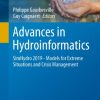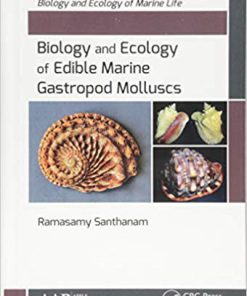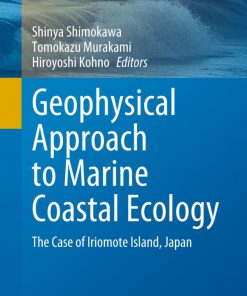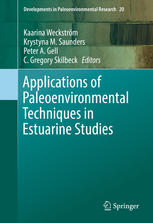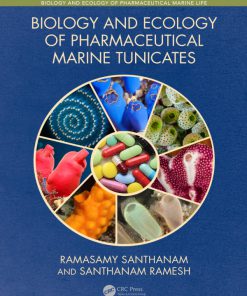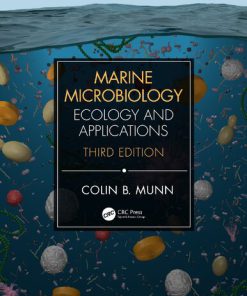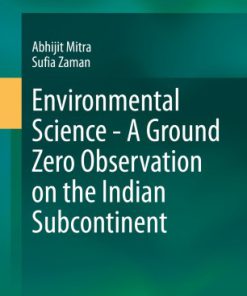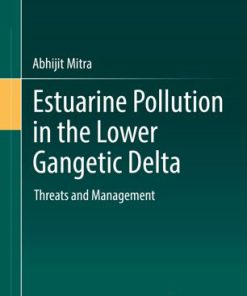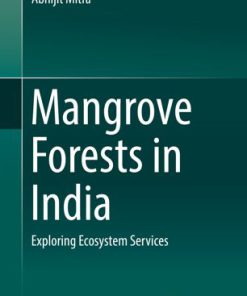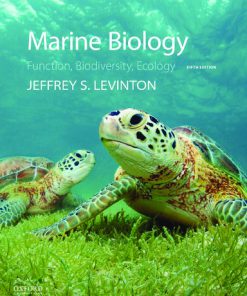Basics of Marine and Estuarine Ecology 1st Edition by Abhijit Mitra, Sufia Zaman 8132227076 9788132227076
$50.00 Original price was: $50.00.$25.00Current price is: $25.00.
Basics of Marine and Estuarine Ecology 1st Edition by Abhijit Mitra, Sufia Zaman – Ebook PDF Instant Download/DeliveryISBN: 8132227076, 9788132227076
Full download Basics of Marine and Estuarine Ecology 1st Edition after payment.
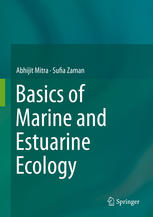
Product details:
ISBN-10 : 8132227076
ISBN-13 : 9788132227076
Author: Abhijit Mitra, Sufia Zaman
The book presents recent research on marine ecology in different parts of the world. It aims to shed light on relevant topics for budding marine ecologists. The “blue soup” of Planet Earth, which comprises both biotic and abiotic components, is essential to keeping the wheel of civilization running. Four major ecosystem service categories have been identified within this context, namely provisioning services such as water, food, mangrove timber, honey, fish, wax, fuel wood, fodder and bioactive compounds from marine and estuarine flora and fauna; regulating services such as the regulation of climate, coastal erosion, coral bleaching and pollution; cultural services encompassing recreational (tourism), spiritual and other non-material benefits; and supporting services such as nutrient cycling and photosynthesis. These valuable services are obtained from various resources that must be conserved for the sake of humanity. This book presents data for each resource type, not just in the form of a simple description, but also through case studies that resulted from several research projects and pilot programs carried out in different parts of the world. Statistical tools were also used to critically analyze the influence of relevant hydrological parameters on the biotic community. Advanced research in marine and estuarine ecology is based on the use of sophisticated instruments, sampling precision, statistical tools, etc., which have also been highlighted in the book.
Basics of Marine and Estuarine Ecology 1st table of contents:
1: Marine Ecosystem: An Overview
1.1 Benthic Compartment
1.1.1 Supralittoral Zone
1.1.2 Eulittoral Zone
1.1.3 Sublittoral Zone
1.1.4 Continental Shelf
1.1.5 Continental Slope
1.1.6 Bathyal Zone
1.1.7 Abyssal Plains
1.1.8 Hadal Zone
1.2 Aquatic Compartment
1.2.1 Classification on the Basis of Light Penetration
1.2.2 How to Estimate the Age of Ocean Water?
1.2.3 Dissolved Oxygen (DO) Consumption Method
1.2.4 Decay Rate of 14C Method
1.2.5 90Sr Content Method
1.2.6 Hydrogen Isotope Method
Brain Churners
Annexure 1A: Oscillation of Seafloor in the Gulf of Mannar
1. Introduction
2. Materials and Methods
3. Results and Discussion
References
Annexure References
2: Estuarine Ecosystem: An Overview
2.1 Definition and Ecosystem Services
2.1.1 Ecosystem Services
2.2 Classification
Brain Churners
Annexure 2A: Blending Mangroves and Livelihood: A March Towards a New Dimension
Annexure 2B: Mangrove Vegetation: A Natural Source of Antioxidant
1. Introduction
2. Materials and Methods
3. Results and Discussion
4. Looking Forward
References
Internet Reference
Annexure References
3: Physical Processes in the Marine and Estuarine Ecosystems
3.1 Waves and Tides
3.1.1 Tides
3.1.2 Theories Related to Tides
3.1.2.1 The Equilibrium Theory
Limitations of the Theory
3.1.2.2 The Dynamical Theory of Laplace
3.1.2.3 Progressive Wave Theory
3.1.2.4 Stationary Wave Theory
3.1.3 Tidal Bore and Tide in Rivers
3.2 Currents
3.2.1 Upwelling and Downwelling: Causes and Significance
3.2.2 Factors Regulating the Pattern and Distribution of Currents
3.2.3 What Happens Practically?
3.2.3.1 Direction and the Shape of the Coastline
3.2.3.2 Seasonal Variations
3.2.3.3 Bottom Topography
3.2.4 El Niño
Brain Churners
Annexure 3A: Oscillation of Hydrological Parameters in and Around Indian Sundarbans
1. Introduction
2. Study Area
3. Materials and Methods
4. Results and Discussion
4.1 Surface Water Temperature
4.2 Surface Water Salinity
4.3 Surface Water pH
4.4 Alkalinity
4.5 Dissolved Oxygen
4.6 BOD and COD
4.7 Nutrients
4.8 Extinction Coefficient
4.9 Sulphate
4.10 Chloride
4.11 Sodium
4.12 Potassium
4.13 Total Nitrogen
5. Conclusion
References
Annexure References
4: Abiotic Variables of the Marine and Estuarine Ecosystems
4.1 Chemical Components
4.1.1 Spatio-temporal Variations of Salinity
4.1.2 Deep-Water Salinity
4.1.3 Conservative and Non-conservative Ions
4.1.4 Dissolved Gases in Seawater
4.1.5 Nutrients
4.2 Sediment Compartment
4.2.1 Transportation of Marine Sediments
4.2.1.1 Rivers
4.2.1.2 River Wash
4.2.1.3 Wave Action
4.2.1.4 Work of Ice
4.2.1.5 Organic Rafting
4.2.1.6 Volcanic Activity
4.2.1.7 Wind
4.2.1.8 Transportation Within the Sea
4.2.2 Classification of Marine Sediments
4.2.3 Ooze: Definition and Type
4.2.4 Sediment Deposition: A Boon or a Curse?
Brain Churners
Annexure 4A: Interannual Variation of Salinity in the Inshore Region of the Bay of Bengal
1. Introduction
2. Materials and Methods
2.1. Study Area
2.2. Data Sources and Quality
2.3. Measurement of Surface Water Salinity
2.4. Statistical Analysis
3. Result
4. Discussion
Annexure 4B: Litmus Test of Climate Change in Indian Sundarbans
1. Introduction
2. Problem Statement
3. Observations: West Versus Central
Annexure 4C: Impact of Climate Change on Fish Community, A Case Study from Indian Sundarbans
Annexure 4D: Acidification of Sundarban Mangrove Estuarine System
1. Introduction
2. Materials and Methods
2.1. Study Site Description
2.2. Aquatic pH
2.3. Mangrove Vegetation Mapping Through Remote Sensing
2.4. Mangrove Vegetation Pool
2.5. Statistical Analysis
3. Results
4. Discussion
5. Conclusion
6. Future Issues
References
Annexure 4A References
Annexure 4B References
Annexure 4C References
Annexure 4D References
5: Producers of the Marine and Estuarine Ecosystems
5.1 Phytoplankton Community
5.1.1 Diatoms
5.1.2 Dinoflagellates
5.1.3 Coccolithophores
5.1.4 Blue-Green Algae
5.1.5 Green Algae
5.1.6 Classification of Phytoplankton
5.2 Macrophytes
5.2.1 Seaweed Community
5.2.2 Mangroves
5.2.3 Seagrass and Salt Marsh Grass
Brain Churners
Annexure 5A: Avicennia alba: An Indicator of Heavy Metal Pollution in Indian Sundarban Estuaries
1. Introduction
2. Materials and Methods
2.1. Sampling of A. alba
2.2. Analysis of Dissolved Zn, Cu and Pb
2.3. Analysis of Biologically Available Zn, Cu and Pb
2.4. Analysis of Tissue Zn, Cu and Pb
2.5. Data Analysis
3. Results
3.1. Dissolved Heavy Metal
3.2. Biologically Available Heavy Metals
3.3. Bioaccumulation Pattern
4. Discussion
5. Looking Forward
Annexure 5B: Regulatory Role of Salinity on Biomass and Carbon Content in Mangroves of Lower Gangeti
1. Introduction
2. Methods
2.1. Study Site Description
2.2. Above-Ground Stem Biomass Estimation
2.3. Above-Ground Branch Biomass Estimation
2.4. Above-Ground Leaf Biomass Estimation
2.5. Litterfall Estimation
2.6. Carbon Estimation in Trees and Litter
2.7. Organic Carbon Analysis in Soil
3. Results and Discussion
3.1. Relative Abundance
3.2. Above-Ground Stem Biomass
3.3. Above-Ground Branch Biomass
3.4. Above-Ground Leaf Biomass
3.5. Litter Production
3.6. Soil Organic Carbon
3.7. Comparison of Carbon Stocks
References
Internet References
Annexure 5A: References
Annexure 5B: References
6: Consumers of the Marine and Estuarine Ecosystems
6.1 Zooplankton Community
6.1.1 Zooplankton: Do They Maintain Uniformity in Their Life Timeline?
6.2 Vertebrate Community
6.2.1 Fishes
6.2.1.1 Agnatha
6.2.1.2 Osteichthyes
6.2.1.3 Chondrichthyes
6.2.2 Reptiles
6.2.2.1 Marine Crocodiles
6.2.2.2 Sea Turtles
6.2.2.3 Marine Lizard
6.2.2.4 Sea Snakes
6.2.3 Sea Birds
6.2.3.1 True Shorebirds
6.2.3.2 Diving Shore Birds
6.2.3.3 Diving Pelagic Birds
6.2.3.4 Penguins
6.2.4 Marine Mammals
6.2.4.1 Whales, Dolphins and Porpoises
6.2.4.2 Baleen Whales
6.2.4.3 Toothed Whales
6.2.4.4 Seals, Sea Lions and the Walrus
6.2.4.5 Manatees and Dugong
6.2.4.6 Sea Otter and Polar Bear
Brain Churners
Annexure 6A: Warming of Lower Gangetic Delta Water, A Projection on the Basis of Real-Time Data
1. Introduction
2. Materials and Methods
2.1. Study Area
2.2. Data Sources and Quality
2.3. Measurement of Surface Water Temperature
2.4. Statistical Analysis
3. Results
3.1. Surface Water Temperature: Real-Time Data
3.2. Surface Water Temperature: Forecast Data
4. Discussion
5. Conclusion
Annexure 6B: Finfish Juvenile Destruction in and Around Mangrove Ecosystem of Indian Sundarbans and
1. Introduction
2. Description of the Study Area
3. Materials and Methods
4. Results and Discussion
A. Root Cause of Tiger Prawn Seed Collection
B. Community Structure of Finfish Juvenile
C. Conservation Measures
Acknowledgement
References
Internet References
Annex 6A: References
Annex 6B: References
7: Decomposers of the Marine and Estuarine Ecosystems
7.1 Overview of Marine and Estuarine Microbes
7.1.1 Marine Organisms as Habitats of Microorganisms
7.1.2 Identification of Marine and Estuarine Microorganisms: A Molecular Genetic Approach
7.2 Importance of Marine and Estuarine Microbes
7.2.1 Production of Antibiotics
7.2.2 Production of Antitumour Compounds
7.2.3 Production of Enzyme
7.2.4 Bioremediation of Petroleum Hydrocarbon
7.2.5 Degradation of Mangrove Litter
7.2.6 Drugs from Marine Microbes
Brain Churners
Annexure 7A: Study on the Quality of Edible Oyster in Indian Sundarbans with Respect to Coliform Loa
1. Introduction
2. Materials and Methods
3. Results and Discussion
Annexure 7B: Study of the Microbial Health in and Around the Lower Stretch of Hooghly Estuary
1. Introduction
2. Aims and Objectives
3. Physiography
3.1. The Ecological Profile
3.2. Climate of Indian Sundarbans
3.3. Wind
3.4. Waves and Tides
3.5. Surface Water Temperature
3.6. Rainfall
4. Materials and Methods
5. Results
5.1 Physico-chemical Parameters
5.1.1 Surface Water Temperature
5.1.2 Surface Water Salinity
5.1.3 Surface Water pH
5.1.4 Surface Water Dissolved Oxygen (DO)
5.1.5 Surface Water Nitrate
5.1.6 Surface Water Phosphate
5.1.7 Surface Water Silicate
5.2 Microbial Load
5.2.1 Total Coliform
5.2.2 Faecal Coliform (FC)
5.2.3 Total Bacterial Count (TBC)
5.2.4 E. coli Count
5.2.5 Vibrio sp. Count
5.2.6 Streptococcus sp. Count
5.2.7 Salmonella sp. Count
6. Discussion
7. Conclusion
References
Internet References
Annexure 7A: References
Annexure 7B: References
8: Adaptation of Marine and Estuarine Organisms
8.1 Adaptation of Organisms in the Intertidal Zone
8.1.1 Adaptation of Biota Inhabiting Rocky Shore
8.1.2 Adaptation of Biota Inhabiting Soft Substratum
8.1.2.1 Adaptation of Biota Inhabiting Sandy Shore
8.1.2.2 Adaptation of Biota Inhabiting Muddy Shore
8.2 Adaptation of Organisms Inhabiting Deep Sea
8.2.1 Morphological Adaptations
8.2.2 Biochemical Adaptations
8.2.3 Vent Communities of the Deep Sea
8.2.4 Properties of Vent Community
Brain Churners
Annexure 8A: Signals of Salinity Fluctuation in Nypa fruticans Seedling Growth, a Case Study from th
1. Introduction
2. Materials and Methods
2.1 Plant Materials and Culture Conditions
2.2 Extraction and Estimation of Pigments
2.3 Statistical Analysis
3. Results and Discussion
Acknowledgments
References
Annexures References
9: Hot Spots of Marine and Estuarine Ecosystems
9.1 Mangroves
9.2 Coral Reefs
9.2.1 Types of Coral Reefs
9.2.2 Coral Reef Characteristics
9.2.3 Reef Productivity
Brain Churners
Annexure 9A: Checklist of Corals in and Around Gulf of Mannar
References
10: Threats to Marine and Estuarine Ecosystems
10.1 Natural Threats
10.1.1 Alteration of the Earth´s Orbit
10.1.2 Natural Oscillation of Atmospheric Carbon Dioxide
10.1.3 Volcanic Activities
10.1.4 Variations in Solar Output
10.1.5 Plate Tectonics
10.1.6 Natural Disasters and Extreme Weather Events
10.1.6.1 Coral Reefs
10.1.6.2 Seagrass
10.1.6.3 Dugong and Turtle
10.1.6.4 Islands
10.2 Anthropogenic Threats
10.2.1 Pollution
10.2.1.1 Effect from Point Sources
Domestic Wastes
Heavy Metals
Oil Spill
Effects of Oil Spills on Marine Biota
Seabirds
Killer Whales
Plankton
Hazardous Materials
Thermal Pollution
Persistent Organic Pollutants (POPs)
Miscellaneous
10.2.1.2 Effect from Non-point Sources
10.2.1.3 Effects from Solid Waste Disposal
10.2.2 Aquaculture
10.2.3 Unplanned Tourism
10.2.4 Introduction of Alien Species
10.2.5 Development of Coastal Structures
10.2.6 Negative Fishing
Brain Churners
Annexure 10A: Impact of Salinity on Above-Ground Biomass and Stored Carbon in a Common Mangrove Exco
1. Introduction
2. Materials and Methods
2.1 Study Area
2.2 Above-Ground Stem Biomass Estimation
2.3 Above-Ground Branch Biomass Estimation
2.4 Above-Ground Leaf Biomass Estimation
2.5 Carbon Estimation
2.6 Salinity
2.7 Statistical Analysis
3. Results
3.1 Relative Abundance
3.2 Above-Ground Biomass
3.3 Carbon Content
3.4 Salinity
4. Discussion
References
Annex A: References
11: Conservation of Marine and Estuarine Resources
11.1 Conservation or Preservation?
11.2 Tiers for Conservation
11.2.1 Habitat Diversity
11.2.2 Community and Ecosystem Diversity
11.2.3 Functional Diversity
11.2.4 Population Diversity
11.2.5 Phyletic Diversity
11.2.6 Species Diversity
11.2.7 Genetic Diversity
Brain Churners
Annexure 11A: International Legal Framework to Safeguard Marine and Estuarine Ecosystems
1. 1982 UNCLOS
2. Agenda 21, Chapter 17 (1992)
3. 1992 Biodiversity Convention
4. The Jakarta Mandate (1995)
5. 1971 Ramsar Convention on Wetlands
6. 1972 World Heritage Convention
7. UNESCO Man and the Biosphere Programme
8. FAO Code of Conduct on Responsible Fisheries
9. Convention of International Maritime Organization
References
12: Instruments and Methods
12.1 Instruments
12.1.1 Instruments Used for Physical Oceanographic Study
12.1.2 Instruments Used for Geological Oceanographic Study
12.1.3 Instruments Used for Chemical Oceanographic Study
12.1.4 Instruments Used for Biological Oceanographic Study
12.2 Application of Satellites in Marine and Estuarine Researches
Brain Churners
Annexure 12A: Study on Soil Organic Carbon in the Intertidal Mudflats of Indian Sundarbans
1. Introduction
2. Materials and Methods
2.1 The Study Area
2.2 Sampling
3. Results and Discussion
3.1 Soil Organic Carbon (SOC)
3.2 Bulk Density
3.3 Organic Carbon Density (OCD)
People also search for Basics of Marine and Estuarine Ecology 1st:
strasbourg thrift store
strasbourg ad 357
the strasbourg bishops’ war
strasbourg 357
battle of strasbourg 357
Tags: Basics of Marine, Estuarine Ecology, Abhijit Mitra, Sufia Zaman
You may also like…
Biology and other natural sciences - Zoology
Biology and Ecology of Edible Marine Gastropod Molluscs 1st Edition Ramasamy Santhanam
Biology and other natural sciences - Ecology
Geophysical Approach to Marine Coastal Ecology The Case of Iriomote Island Japan Shinya Shimokawa
Engineering
Applications of Paleoenvironmental Techniques in Estuarine Studies 1st Edition Kaarina Weckström
Biology and other natural sciences
Marine Microbiology: Ecology & Applications Third Edition Colin B. Munn
Earth Sciences - The Environment
Environmental Science A Ground Zero Observation on the Indian Subcontinent Abhijit Mitra
Earth Sciences - The Environment
Estuarine Pollution in the Lower Gangetic Delta Threats and Management Abhijit Mitra
Biology and other natural sciences - Ecology
Mangrove Forests in India: Exploring Ecosystem Services Abhijit Mitra
Biology and other natural sciences - Genetics
Marine Biology: – Function, Biodiversity, Ecology 1st Edition Jeffrey S. Levintons


